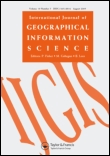
INTERNATIONAL JOURNAL OF GEOGRAPHICAL INFORMATION SCIENCE
Scope & Guideline
Pioneering Research in Geographical Information Systems
Introduction
Aims and Scopes
- Spatial Data Analysis and Modeling:
The journal explores various methods for analyzing spatial data, including statistical techniques, machine learning, and geostatistics, enabling researchers to extract meaningful insights from complex geographical datasets. - Geospatial Technologies and Applications:
It emphasizes the development and application of geospatial technologies such as GIS, remote sensing, and spatial databases, fostering advancements in urban planning, environmental monitoring, and disaster management. - Human Mobility and Social Dynamics:
Research within this scope examines patterns of human mobility, social interactions, and their implications on urban and rural environments, contributing to a deeper understanding of spatial behaviors and trends. - Geovisualization and Cartography:
The journal promotes studies on innovative geovisualization techniques and cartographic practices that enhance the interpretation and communication of spatial information. - Environmental and Sustainability Studies:
It encompasses research focused on environmental assessment, sustainability, and the impact of geographical factors on ecological systems, supporting informed decision-making for sustainable development.
Trending and Emerging
- Integration of Artificial Intelligence and Machine Learning:
There is a significant increase in research that combines AI and machine learning techniques with GIScience, reflecting a trend towards automating spatial analysis and enhancing predictive modeling capabilities. - Geospatial Big Data Analytics:
The rise of big data in geospatial contexts has led to a surge in studies focusing on the management, analysis, and visualization of large-scale spatial datasets, addressing challenges such as data quality and computational efficiency. - Spatial-Temporal Dynamics and Mobility Studies:
Emerging themes include the analysis of spatial-temporal dynamics in human mobility, emphasizing the role of mobility patterns in urban planning and public health. - Crowdsourced and Volunteered Geographic Information (VGI):
Research exploring the use of crowdsourced data and VGI is gaining traction, focusing on its implications for participatory planning and real-time decision-making. - Geospatial Applications in Public Health and Social Issues:
There is an increasing focus on applying GIScience to address public health challenges and social issues, such as disease spread modeling and the impacts of climate change on vulnerable populations.
Declining or Waning
- Traditional Cartography:
There has been a noticeable decline in papers dedicated solely to traditional cartographic methods, as the field increasingly integrates digital and interactive mapping technologies. - Static Spatial Models:
Research focusing on static or simplistic spatial models is waning, with a growing preference for dynamic and complex models that better reflect real-world phenomena. - Regional Planning without Data Integration:
Papers that approach regional planning without considering integrated data sources and advanced analytics are appearing less frequently, indicating a shift toward more comprehensive methodologies.
Similar Journals

SYSTEM
Empowering scholars with cutting-edge insights in language education.SYSTEM is a premier scholarly journal dedicated to the fields of Education and Linguistics, published by Elsevier Science Ltd. With a notable impact factor and recognition as a Q1 journal in both Education and Linguistics for 2023, SYSTEM stands out among its peers, ranking at the 12th and 13th position in the respective Scopus categories, placing it in the top 2% of its field. Since its inception in 1973, the journal has provided a platform for innovative research that explores critical issues in language education, applied linguistics, and the intersection of technology and learning. While this journal does not offer open access, it remains highly regarded for its rigorous peer-review process and commitment to advancing knowledge. Researchers, professionals, and students alike will find SYSTEM an invaluable resource for cutting-edge studies and insights that drive the academic discourse in language and education.
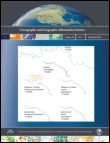
Cartography and Geographic Information Science
Mapping the Future of Geographic KnowledgeCartography and Geographic Information Science is a premier journal published by Taylor & Francis Inc, focusing on the interdisciplinary realms of geography, planning, and technological innovation. With an impressive impact factor and ranking in the top quartiles across various categories, including Q1 in Geography, Planning and Development and Q2 in Civil and Structural Engineering, this journal serves as an essential resource for researchers, professionals, and students alike, promoting cutting-edge research and advancements in cartography and geographic information systems. The journal disseminates high-quality articles that explore both theoretical and practical aspects of geographic information, aiming to enhance the understanding and application of spatial data. As the field evolves, Cartography and Geographic Information Science remains a vital forum for innovation and scholarly dialogue, offering accessible content to a global audience. With its commitment to rigor and relevance, it plays a critical role in advancing the landscapes of geography and environmental sciences.

Geo-Spatial Information Science
Connecting Researchers and Practitioners through Geospatial InsightsGeo-Spatial Information Science, published by TAYLOR & FRANCIS LTD, is a premier open-access journal that has been at the forefront of disseminating cutting-edge research since its inception in 1998. With an ISSN of 1009-5020 and an E-ISSN of 1993-5153, this journal plays a pivotal role in the fields of Computers in Earth Sciences and Geography, Planning and Development, achieving a prestigious Q1 ranking in both categories as of 2023. Its exemplary Scopus rankings highlight its relevance within the social sciences and earth sciences, placing it among the top echelons of its field, with a 95th and 93rd percentile respectively. The journal aims to bridge the gap between innovative geospatial technologies and their applications in real-world scenarios, fostering interdisciplinary collaboration and advancing the global understanding of spatial data analysis. Based in the United Kingdom, Geo-Spatial Information Science invites researchers, professionals, and students to contribute and access research that shapes the future of geo-spatial sciences, all while adhering to open access principles that ensure broad dissemination and engagement with the broader academic community.
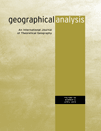
GEOGRAPHICAL ANALYSIS
Exploring the Depths of Earth-Surface ResearchGEOGRAPHICAL ANALYSIS, published by WILEY, is a premier scholarly journal that has been at the forefront of geographical and earth-surface research since its inception in 1969. With an ISSN of 0016-7363 and an E-ISSN of 1538-4632, this journal has established itself as an essential resource for researchers and professionals in the fields of Earth-Surface Processes and Geography, Planning and Development, achieving impressive rankings of 13th and 60th in their respective categories according to Scopus, placing it in the Q1 quartile for both. The journal is renowned for its rigorous peer-reviewed articles that contribute valuable insights into spatial analysis, environmental impacts, and urban planning, thus fostering a deeper understanding of geographical phenomena. With access options available through traditional subscriptions, GEOGRAPHICAL ANALYSIS continues to serve as a critical platform for the dissemination of cutting-edge research and innovative methodologies, ultimately shaping the future of geographical inquiry and application.

Boletim de Ciencias Geodesicas
Pioneering Discoveries in the Dynamic World of GeodesyBoletim de Ciências Geodésicas is an esteemed academic journal published by the Universidade Federal do Paraná within its Centro Politécnico. Focused on the dynamic field of Earth and Planetary Sciences, this Open Access journal has been a pivotal resource since 1997, fostering the dissemination of critical research and innovative methodologies. With an impact factor indicative of its relevance in the discipline, Boletim de Ciências Geodésicas ranks in the Q3 quartile for Earth and Planetary Sciences as of 2023, showcasing its commitment to quality scholarship in a competitive field. Researchers and students alike will benefit from access to cutting-edge findings, given its broad scope that encompasses various aspects of geodesy and related sciences. The journal's convergence of research from 2005 to 2024 ensures that it remains at the forefront of emerging trends and fundamental developments in the discipline, further enhancing its esteemed reputation in the academic community.

South African Journal of Geomatics
Unlocking the Potential of Geomatics for AllSouth African Journal of Geomatics is a pivotal platform dedicated to the advancement of geomatics, focusing on the dynamic intersection of geographic information science, surveying, and mapping technologies. Published by CONSAS CONFERENCE, the journal serves as a crucial resource for researchers, professionals, and students in the geomatics field, providing insightful, peer-reviewed articles that explore contemporary challenges and innovations. Operating under an open-access model, the journal ensures the wide dissemination of knowledge, promoting collaboration and scholarly exchange among the global geomatics community. With a commitment to enhancing the visibility of significant research and fostering academic discourse, the South African Journal of Geomatics plays a vital role in contributing to the development of this essential discipline in South Africa and beyond.
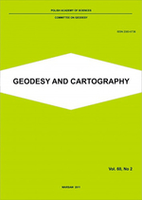
Geodesy and Cartography
Empowering Collaboration in Geospatial SciencesGeodesy and Cartography, published by the Polska Akademia Nauk (Polish Academy of Sciences), is a premier open-access journal dedicated to advancing the fields of geodesy, cartography, and geographic information science. Since its inception in 2010, the journal has provided a vital platform for researchers, professionals, and students to share their findings, fostering innovation and collaboration in these critical areas of study. With its ISSN 2080-6736 and E-ISSN 2300-2581, the journal is accessible to a global audience, ensuring that cutting-edge research is readily available to enhance scientific understanding and application. The journal not only serves as a repository of knowledge but also aims to contribute to the development of best practices and methodologies within geospatial sciences, making it an essential resource for anyone invested in the ever-evolving landscape of mapping and spatial data analysis.

GEOINFORMATICA
Transforming Spatial Knowledge into Actionable InsightsGEOINFORMATICA is a leading journal in the field of geoinformatics, widely recognized for its contributions to both Geography, Planning and Development as well as Information Systems. Published by Springer, this journal holds a distinguished Q1 ranking in Geography and a Q2 ranking in Information Systems as of 2023, reflecting its high-impact research contributions and authoritative voice in these disciplines. Since its inception in 1997, GEOINFORMATICA has provided a platform for innovative research, methodologies, and applications related to geographic information science, spatial data analysis, and remote sensing technologies. The journal's rigorous peer-review process and strategic positioning within the academic landscape allow it to attract a diverse array of publications, assisting researchers, professionals, and students in understanding complex spatial phenomena. While the journal does not offer Open Access, it remains a vital resource located in the Netherlands, and its indexed status has secured impressive Scopus rankings—#131 in Geography, Planning and Development, and #134 in Information Systems, showcasing its robust scholarly influence. Explore the latest developments and cutting-edge research through GEOINFORMATICA, where scholarly excellence converges with real-world relevance.
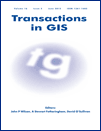
Transactions in GIS
Connecting Theory and Practice in GISTransactions in GIS is a premier academic journal published by WILEY, dedicated to advancing the field of Geographic Information Science (GIS). With an ISSN of 1361-1682 and an E-ISSN of 1467-9671, this journal has continually contributed valuable insights since its inception in 1996, transforming the landscape of GIS research and application. Covering a broad scope within Earth and Planetary Sciences, it holds a notable Q2 ranking and stands in the 74th percentile among its peers as per Scopus rankings. The journal serves as a critical platform for researchers, professionals, and students who seek to disseminate and engage with innovative GIS methodologies, applications, and theoretical advancements. With a commitment to quality and rigor, Transactions in GIS remains a vital resource for those at the forefront of geographic research and analysis.
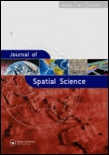
Journal of Spatial Science
Transforming Understanding of Our Spatial WorldThe Journal of Spatial Science, published by Taylor & Francis Ltd, serves as a prominent platform for the dissemination of research in the interdisciplinary fields of geography, atmospheric science, and energy. With an ISSN of 1449-8596 and an E-ISSN of 1836-5655, this journal has established itself as a vital resource since its inception in 2004, boasting an impressive convergence period extending to 2024. Recognized in the Q3 quartile for Atmospheric Science and Energy (miscellaneous), and achieving a Q2 classification in Geography, Planning and Development in 2023, the journal not only reflects the evolving complexities of spatial science but also underscores its increasing relevance in addressing contemporary global challenges. The journal holds a commendable position in Scopus rankings, with notable placements in various categories, further highlighting its academic significance. Researchers, professionals, and students are encouraged to engage with the rich content offered, as the Journal of Spatial Science remains committed to advancing knowledge and fostering discussions pertinent to spatial analysis and its applications.